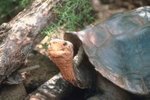
The pancake tortoise is unusual among turtles not just because of its namesake flattened appearance. It has the unusual habit of running away from predators. Unlike most other tortoises, pancake tortoises are quite quick and agile. They can "dart" to rocky hideouts to escape danger rather than tucking into their shells.
Description
The pancake tortoise is most easily identified by its unusually flattened profile. Unlike all other tortoises, which possess domed shells, the pancake tortoise has only a slightly curved upper shell. Individuals of the species may reach a length of about 7 inches, but they rarely are more than an inch and a half in height. The shell is flexible at the joints between each scute or section of shell plating. Their coloration is tawny to golden brown with dark lines surrounding each section of shell.
Habitat
Native to Kenya and Tanzania, the pancake tortoise is most frequently found along rocky outcroppings in arid parts of the African scrub. They inhabit a wide range of altitudes, from 100 feet to well over 6,000 feet above sea level. This varied altitude means these tortoises are able to cope with a wide range of temperatures. Pancake tortoises rely heavily on the shelter of rocky crevasses and therefore do not tend to migrate far from where they were born.
Behavior and Diet
Pancake tortoises never stray far from their hiding places among the rocky kopjes. When threatened, they do not tuck their heads and legs into their shells like other tortoises; instead they dash, as it were, to the nearest crevasse and wedge themselves firmly out of reach. Pancake tortoises are mainly active in the mornings, basking and feeding on dried grasses and whatever vegetation is available in the arid savannah.
Reproduction and Conservation
Breeding occurs in January and February. Females lay eggs one or two at a time every six weeks throughout the season. Eggs can take four to six months to hatch. Their relatively low reproductive capacity, combined with the tortoise’s high demand in the collector pet trade, has led to a drop in their numbers in the wild. An effort to protect their numbers has made it illegal to import wild-caught tortoises.
References
Photo Credits
-
NA/PhotoObjects.net/Getty Images




